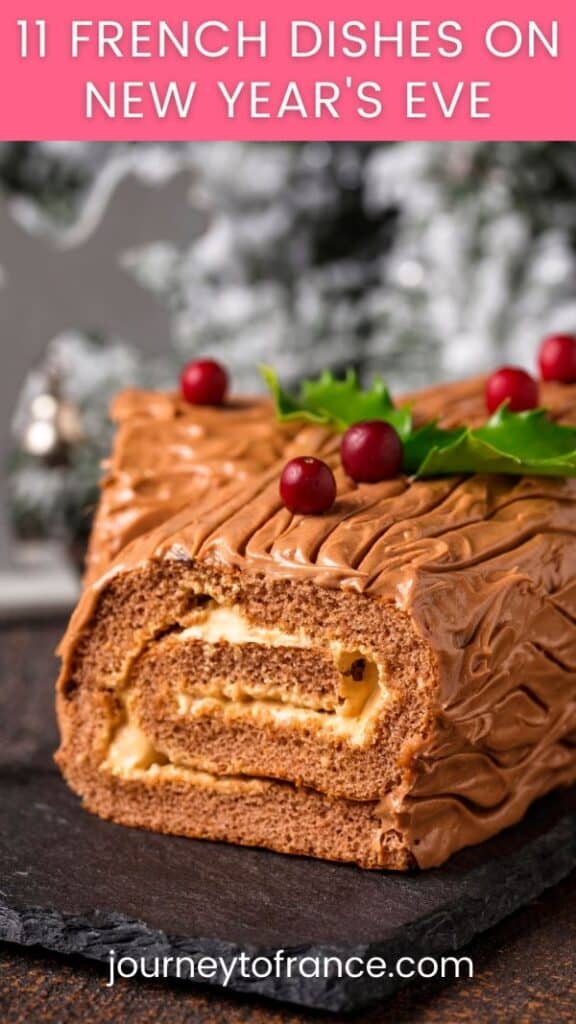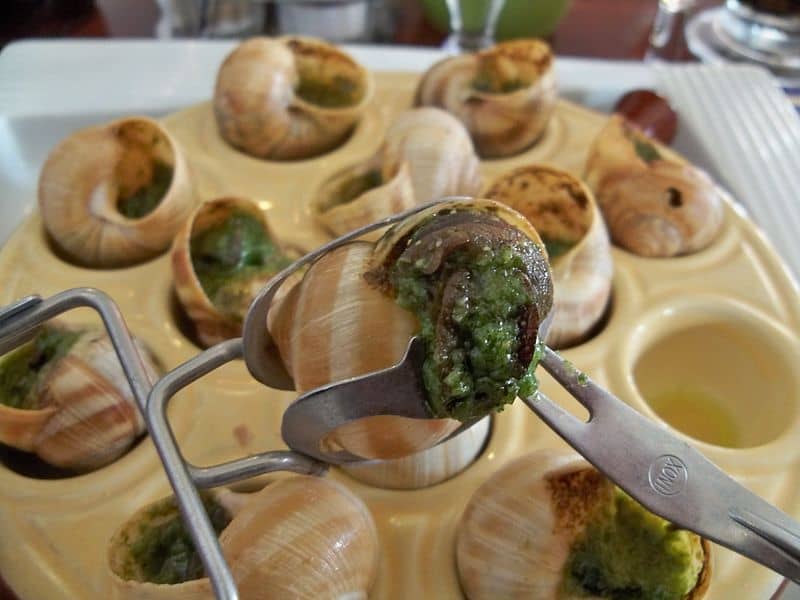Are you looking for the best and most popular French dishes to deserve on New Year’s eve?
The people of France ring in the New Year with a celebration known as la Saint-Sylvestre. Sylvester was the 33rd Pope, who served from 314 to 335 A.D., a span of about twenty-two years. Christianity became the state religion of the Roman Empire under his rule.
However, December 31st’s patron saint, Saint Sylvestre, has nothing to do with the New Year. The Gregorian calendar is to blame for this mere happenstance. On the French calendar, a saint is honored annually on each of the 365 days.
In France, New Year’s Eve is traditionally the start of the holiday season, and it is called Le Réveillon de Saint-Sylvestre. Pancakes, foie gras, and champagne all make appearances at the traditional meal. French custom holds that those who partake in this meal will be showered with good fortune for the coming year.
This New Year’s Eve party can be anything from a quiet dinner with close friends to a vast, dance-filled gala. After midnight, everyone gathers under the mistletoe to exchange kisses and New Year’s greetings. In France, the ritual of kissing beneath the mistletoe is associated more with the New Year’s holiday than with Christmas.
So, what exactly do the French serve for New Year’s Eve dinner? They range from seafood and beef dishes to desserts rarely seen outside the holiday season. If you’re interested in having some traditional French dishes on New Year’s Eve, check out our list below.
You can also check out our other French food articles below:
- French Dishes For Christmas
- Most Popular Traditional French Food
- Popular French Food Facts
- Baguette Fun Facts
- Interesting Facts About Foie Gras
- Weird French Foods To Try
- Popular French Breakfast Dishes
- Popular French Dinner Dishes
- Popular French Desserts
Things you'll find in this article
11 French Dishes on New Year’s Eve

1. Chestnut Soup

Although onion soup is more common in Paris, chestnut soup is a delicious alternative.
Chestnuts, a nut brought to France by the Romans, are the star of this flavorful soup. This soup would be great with buttered crusty bread as a side, as an appetizer, or even as a meal on its own.
Start the new year off right with this hearty meal. Enjoy the sweet earthiness of this simple soup with duck confit or shredded pork rillette, or neither if you’re a vegetarian!
2. Les Verrines

Appetizers or desserts known as “les verrines” are composed of various food components arranged in a translucent bowl or glass. The word “glass” in French is “verre,” which is where the name comes from.
The ingredients are arranged to highlight the varying colors and textures of each layer. Les verrines are almost the same as the method used to produce a seven-layer dip but are significantly more polished and delicate.
The verrines are an essential part of the New Year’s Eve meals served in France.
3. Blinis

Blinis are savory mini pancakes that are traditionally made in France using yeast. These should not be confused with crepes or Russian blinis (a leavened batter).
At dinners and celebrations, Blinis are typically served as an appetizer comparable to a cracker or canapé. Then they top it with savory garnishes like creme fraiche and caviar or smoked salmon and cucumbers. Blinis are easy to prepare and can be found at almost any store in France.
Blinis are also New Year’s Eve staples in France, and you may even find them served in many French homes. These are made with the help of a blini maker or an electric raclette machine.
4. Escargot

It is a common misconception that all French people consume escargot. However, those who do consume escargot typically do so during special dinners or around holidays like New Year’s and Christmas. This explains why more than half of all escargot sales in France occur around the end of the year.
The following are two of the most common preparations for escargot:
Escargots au gratin – These are prepared by layering escargot with mushrooms, the bottom of an artichoke, spinach, then béchamel sauce, and Swiss cheese.
Mille Feuilles d’Escargots – This one is made with homemade puff pastry and is filled with escargot and mushrooms that have been seasoned with parsley, garlic, and butter sauce.
5. Foie Gras

The French term “foie gras” literally translates to “fat liver,” and it refers to the liver of a duck or goose that has been fattened through the use of a feeding tube.
Despite the controversy surrounding the process of producing foie gras by force-feeding, foie gras is enthusiastically consumed throughout the entire year in France, particularly around the holidays, as part of New Year’s Eve celebrations, as well as the beginning of the new year.
6. Crustacés et Coquillages

Often served in larger New Year’s Eve parties in France,
If you’re incredibly fortunate, the Crustacés et Coquillages is usually a tray with a range of other shellfish and crustaceans that were kept cold in a bowl.
If there are prawns (Gambas) on the platter, you should not be surprised to see the heads, eyes, and antennae still attached to the prawns. To eat prawns like the French, you must first pinch off the head and, if you dare, suck out the juice before eating the actual flesh of the prawn.
There is also a possibility that you will come upon uncooked cockles, mussels, and sea urchins.
7. Confit de Canard
You may have been aware of the fact that duck is one of the most traditional meals served on New Year’s Eve dinner in France. This is a staple in French dinner tables during New Year’s Eve. Served as a main dish, duck legs are first salted with herbs and braised in a liquid. Then they are
roasted until they reach the required level of crispiness.
8. Daube de Boeuf à la Gascogne
Beef is an alternative for those individuals who are unable to stomach the thought of eating duck. In addition to Madiran, wine, armagnac, and chocolate are used in the preparation of this hearty stew with beef and root vegetables.
This mouthwatering beef meal tastes excellent when it’s served over noodles. Make sure to also have enough crusty bread available so that guests can sop up all of the flavorful sauce.
This is a traditional dish served on New Year’s Eve in France. It is also a delicious and hearty dish that is perfect for the colder months of the year.
9. Saumon Fumé
The smoked salmon (Saumon Fumé), nearly always served cold, is frequently a part of a Verrine, Blinis, or delicate canapés with chives and crème fraîche. This is often served during New Year’s Eve celebrations and is ideal for those who don’t want to eat escargot, raw oysters, or mussels.
The versatility of saumon fumé is one of its many appealing qualities. The meat might be the main meal, served with a tasty sauce. This seafood delicacy can be prepared in several ways, each of which pairs well with a variety of wines due to its lightness, delicacy, and full flavor.
A New Year’s Eve celebration with a glass of champagne and some smoked salmon is one of the best culinary experiences in France if you’re there during the holidays.
10. Gateau Millasson
The Gateau Millasson is a classic dessert that is served as part of the French New Year’s Eve menu. It is a traditional egg custard dish that is made with flour.
Corn flour is typically used in the preparation of this French egg custard, although you can use wheat flour instead with satisfactory results. During the cooking process, it develops a spectacular puff, and then it settles into a rich, delicately sweet flan.
11. Bûche de Noel (Yule Log)

It is believed that the first yule logs were baked in the 1600s. The 19th-century Parisians took the cakes and made them into exquisite pieces of gastronomic art that helped promote them throughout the world.
However, unlike in most parts of the world,you will also see Yule logs taking a special place in French New Year’s Eve gatherings.
They come in a wide variety of forms, but the standard is a rolled sponge cake covered in a chocolate or nut buttercream icing, a fruity glaze, and scrumptious embellishments. Whatever you decide, it’ll be a great way to get the whole family together.

Hi, I’m Christine – a full-time traveler and career woman. Although I’m from the Philippines, my location independent career took me to over 40 countries and lived in 4 continents in the last 10 years, including France. A self-proclaimed Francophile, I love everything France.
